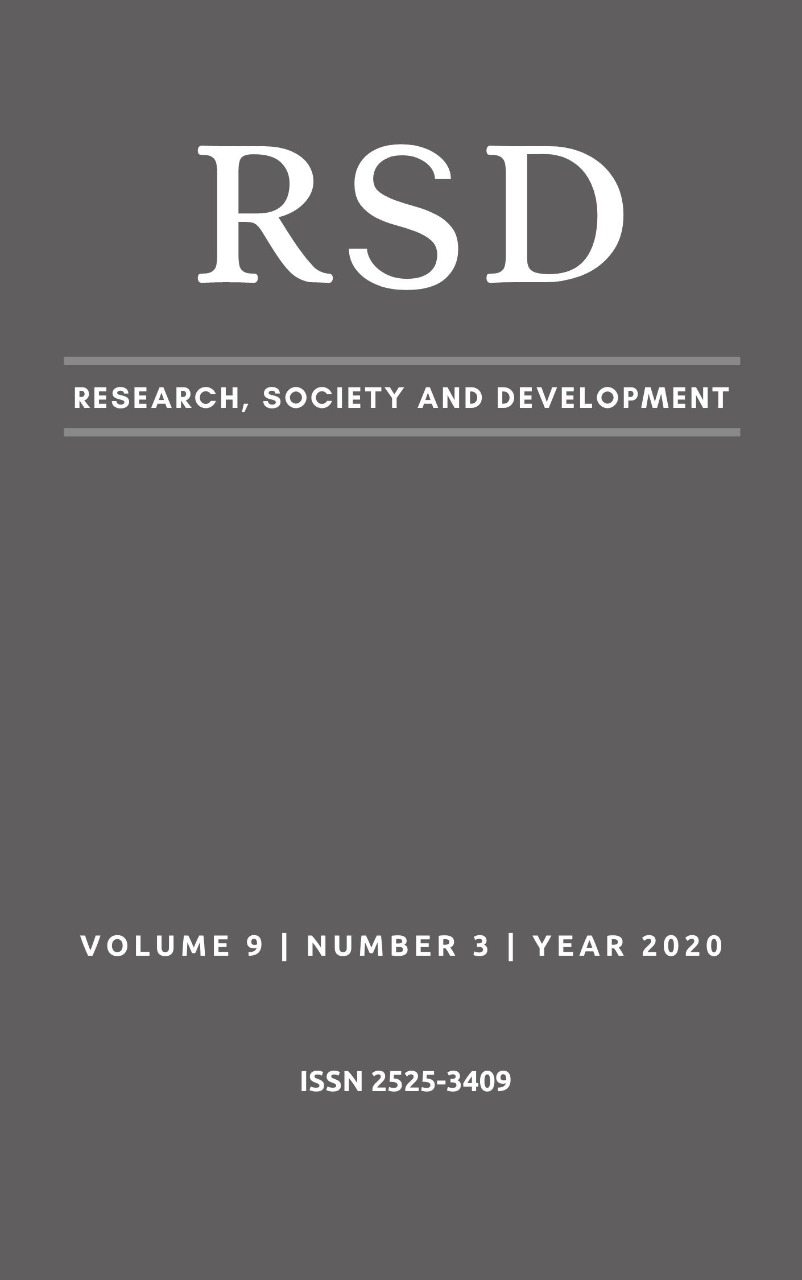Uso da energia solar como fonte alternativa para o aquecimento de utilidades: simulação e controle
DOI:
https://doi.org/10.33448/rsd-v9i3.2730Palavras-chave:
Controlador on/off, Controlador PI, Energia Solar, Modelagem.Resumo
A energia solar se tornou uma das formas de energia alternativa mais utilizada, por ser uma fonte renovável e não poluente. Sendo assim, sistemas de aquecimento solar vêm sendo cada vez mais empregados nos setores residenciais e industriais. Todavia, em períodos com baixa ou nenhuma luminosidade solar, a sua eficiência fica prejudicada. Partindo desse pressuposto, o presente trabalho propõe a modelagem matemática de um sistema auxiliar de aquecimento de utilidades industriais, empregando a energia solar como fonte alternativa. Sendo avaliados três tipos de configurações para o sistema de aquecimento: sistema I - sem coletor solar, sistema II - com coletor solar funcionando 24 h por dia, e sistema III - sistema híbrido, no qual coletor solar é acionado apenas durante o período em que há incidência de radiação solar (10h – 17h). Para o melhor aproveitamento das fontes de energia disponíveis (renovável e não renovável) propõe-se a implementação de controladores do tipo on/off e do tipo PI, nas configurações estudadas. O modelo matemático proposto foi simulado usando o software livre Scilab®. Analisando os resultados obtidos pela simulação, o sistema híbrido apresentou maior economia de energia, cerca de 8%, quando comparado ao sistema I. Para os casos utilizando controladores, quando comparados ao sistema sem controlador, aquele que se mostrou mais adequado foi o com controlador PI implementado ao sistema híbrido, apresentando uma economia de 60W de energia, por dia de operação.
Referências
Cardoso, R. B. & Campos, O. C. (2017). Impacts of climate variables in energy generation on the photovoltaic system of the UNIFEI, in Itabira city. Revista SODEBRAS, 12, 295-299.
Fonseca, J. P. S. M. & Ferrari, E. M. M. & Cardoso, R. B. (2018). Análise dos impactos energéticos e econômicos do programa brasileiro de etiquetagem energética (PBE/Inmetro) em coletores solares térmicos do Brasil. Research, Society and Development, 7(1), 01-17. doi:10.17648/rsd-v7i1.101
Fontalvo, A. & Garcia, J. & Sanjuan, M. & Padilla, R. V. (2014). Automatic control strategies for hybrid solar-fossil fuel power plants, Renewable Energy, 62, 424-431. doi:10.1016/j.renene.2013.07.034
Franco, P. R. V. & Lugli, A. B. & Henriques, J. P. C. (2014) Comparação entre sistemas de controle para fornos industriais. Brazil Automation, 1,1-18.
Gnoatto, E. & Dallacort, R. & Ricieri, R. P. & Silva, S. L.; Ferruzi, Y. (2008). Eficiência de um conjunto fotovoltaico em condições reais de trabalho na região de Cascavel. Acta Sicentiarum Technology, Maringá, 30(2), 215-219. doi:10.4025/actascitechnol.v30i2.5496
Gomes Filho, C. A. (2013). Análise preliminar para estimativa da perda de calor sensível de um fluido homogêneo térmico em um reservatório de geométrica cilíndrica. Trabalho de conclusão de curso. Faculdade de Engenharia (FEG). Universidade Estadual Paulista, Guaratinguetá.
Incropera, F. P. & Dewitt, D. P. & Bergan, T. L. & Lavine, A. S. (2011). Fundamentos de Tranferência de Calor e Massa, 6 ed. Rio de Janeiro: LTC.
Instituto Nacional de Meteorologia. (2018). Acessado em 09 janeiro 2018, em: http://www.inmet.gov.br/portal/.
Kicsiny, R. (2015). Transfer function of solar heating systems for dynamic analysis and control design. Renewable Energy, 77, 64-78. doi: 10.1016/j.renene.2014.12.001
Kicsiny, R. (2018). Black-box model for solar storage tanks based on multiple linear regression. Renewable Energy, 125, 857-865. doi: 10.1016/j.renene.2018.02.037
Kicsiny, R. & Nagy, J. & Szalóki, Cs.(2014). Extended ordinary differential equation models for solar heating systems with pipes. Applied Energy, 129, 166-176. doi:10.1016/j.apenergy.2014.04.108
Kicsiny, R. & Varga, Z. (2012). Real-time state observer design for solar thermal heating systems. Applied Mathematics and Computation, 218, 11558-11568. doi:10.1016/j.amc.2012.05.040
Martins, F. R. & Abreu, S. L. & Pereira, E. B. (2012). Scenarios for solar termal energy application in Brazil. Energy Policy, 48, 640-649. doi: 10.1016/j.enpol.2012.05.082
Medeiros, M.& Nogueira, C. E. C. & Siqueira, J. A. C. & Lawder, J. H. & Souza, S. N. M. & Fracaro, G. P. M. (2013). Optimizing a mixed water heating system (solar and electric) for rural areas. Acta Scientiarum Techonlog, Maringá, 35 (1), 69-74. doi:10.4025/actascitechnol.v35i1.11998
Mekhilef, S. & Saidur, R. & Safari, (2011). A review on solar energy use in industries. Renewable and Sustainable Energy Reviews, 15, 1777-1790. doi: 10.1016/j.rser.2010.12.018
Oliveira, N. M. B. & Damasceno, J. J. R. & Vieira, L. G. M. (2009). Aprimoramento de aquecedores solares de baixo custo. Uberlândia: UFU.
Pereira, E. B & Martins, F. R. & Gonçalves, A. R. & Costa, R. S. & Lima, F. J. L. & Rüther, R. & Abreu, S. L. & Tiepolo, G. M. & Pereira, S. V. & Souza, J. G. (2017). Atlas brasileiro de energia solar. 2.ed. ‐‐ São José dos Campos : INPE.
Silva, R. M. (2015). Energia Solar no Brasil: dos incentivos aos desafios. Brasília: Núcleo de Estudos e Pesquisas/CONLEG/Senado.
Tavares, S. R. & Sousa, N. G. (2018). Sistema de aquecimento solar de água: simulação e análise, Revista Brasileira de Ciência, Tecnologia e Inovação, 4(1), 15-31. doi:10.18554/rbcti.v4i1.3360
Yunus, A. C. & Moura, L. F. M. & Ismail, K. A. R. (2009). Transferência de calor de massa: uma abordagem prática. 3 ed. São Paulo: MCGraw-Hill do Brasil.
Downloads
Publicado
Edição
Seção
Licença
Autores que publicam nesta revista concordam com os seguintes termos:
1) Autores mantém os direitos autorais e concedem à revista o direito de primeira publicação, com o trabalho simultaneamente licenciado sob a Licença Creative Commons Attribution que permite o compartilhamento do trabalho com reconhecimento da autoria e publicação inicial nesta revista.
2) Autores têm autorização para assumir contratos adicionais separadamente, para distribuição não-exclusiva da versão do trabalho publicada nesta revista (ex.: publicar em repositório institucional ou como capítulo de livro), com reconhecimento de autoria e publicação inicial nesta revista.
3) Autores têm permissão e são estimulados a publicar e distribuir seu trabalho online (ex.: em repositórios institucionais ou na sua página pessoal) a qualquer ponto antes ou durante o processo editorial, já que isso pode gerar alterações produtivas, bem como aumentar o impacto e a citação do trabalho publicado.


